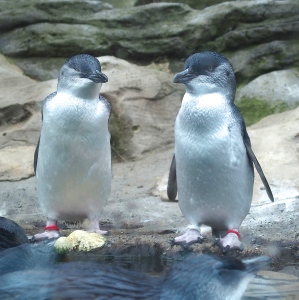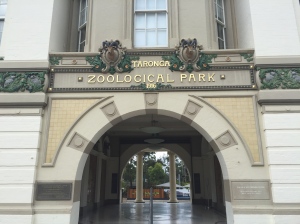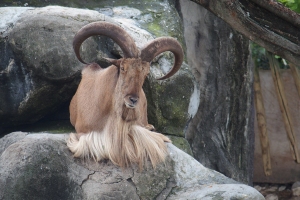Lone Pine Koala Sanctuary
Our old Hong Kong friend Cindy Hamilton recommended the Lone Pine Koala Sanctuary in Brisbane. We hadn’t seen a koala yet, so we said sure, even though we aren’t usually zoo people.
What a great recommendation! We spent the whole day, seeing koalas and so much more.

This poor koala was petted by 50 people before me. Several put their cheeks right next to him. Note how the handler has a strong grip on his hands with sharp claws.
The common thinking about koalas is that they’re cute and cuddly and lazy. They are cute. Not too cuddly, with their sharp claws. They’re sleepy, but definitely not because they’re lazy.
We learned that koalas sleep for up to 20 hours a day, not from laziness, but because of chemistry. When they’re awake they seem to be constantly eating. They eat eucalyptus leaves.
However, the leaves they eat are only 5% sugar so the energy content is extremely low. They simply don’t have the caloric intake to let them run around like animals.
In this part of Australia, southern Queensland, the koala is a protected animal. Human settlement, including lots of pet dogs, has driven the little marsupials out of the region. We were told that they were being culled in northern Queensland, however, presumably because they are such “pists.”

One or both of these koalas will probably fall asleep before this turns into a duel.
Anyway, they are still cute.
Another endangered animal is the cassowary, the world’s second-largest bird (after the ostrich). The distinctive blue neck and crested head give it a very interesting look. If encountered in the wild, it will use its strong legs and sharp claws to make an offensive attack. It can’t fly.
Far more approachable, at least in the koala sanctuary, are the emus. Here we inched our way closer and closer to these large flightless birds, hoping to get a photo before they ran away.
They actually seemed interested in the camera. This bird would probably be one of the first in the animal word to take up selfies.
In this same enclosure were junior kangaroos. If there is such a thing as a tame kangaroo, these are they. After the warning we had from our Southern Rocks friend of the extreme danger in getting close to kangaroos, we tut-tutted the other tourists who were petting them, kissing them, and lying next to them for selfies. Eventually we did the same, except not the lying down part because of all the kangaroo fewmets. Well, eventually we did that too, but not the kissing part.
As we headed out, we ran into feeding time for the rainbow lorikeets. At 4PM no birds were visible in the trees near the feeding station. When the ranger approached with the food, one or two birds seemed to be acting as scouts. She filled about a dozen small handheld trays with oatmeal-looking gruel. Within a minute or so, dozens of colorful birds flocked to the feeders.

Rainbow lorikeets love their gruel.

Close-up of a rainbow lorikeet.
It’s amazing how much time we spent at the Koala Sanctuary, even without any kids along. Later we visited Sydney’s Taronga Zoo and stayed seven hours until we were kicked out. Here’s why…
Taronga Zoo
Throughout the day, the Taronga Zoo offers visitors animal talks and opportunities to interact with the animals. As soon as we entered, Michael had his first close encounter.
The zoo has lots of reptiles and amphibians.

The croc was being fed whole fish. Rangers stood behind a fence just slightly thicker than these wires.
Komodo Dragons can grow to 8 feet long, and weigh 80 kilos (176 pounds). They’re carnivores and can eat up to 80% of their weight in one sitting. So if you weigh 140 or less, you’re a goner.

The Australian green tree frog is known simply as the green tree frog here. He’s as lovable as Kermit.
And then we saw giraffes. Of course, we know giraffes have long necks, but it’s one thing to read that or see a photo and another to stand near a living, moving giraffe.

The giraffes have some of the best views of the Sydney Opera House. Psst: You’re looking the wrong way.
The lemur appears to have been built by committee. What is the purpose of this long and decorative tail?

The lemur’s tail is down when perched in a tree, but straight up in the air when it scampers over the ground.
When we visited Australia in 1999, we picked up small stuffed animals for the kids: koala, kangaroo, emu, platypus, and echidna. These were all very soft and fluffy. The echidna is anything but fluffy. This is an echidna in real life:
It has sharp bristles like a porcupine, but doesn’t throw them off when threatened. Instead it rolls into a ball, so any animal trying to attack it simply can’t find a spot to touch it without hitting the barbs. Isn’t nature clever?
For Patrick, we had to look for tigers. When we played 20 questions when he was a kid, we were able to guess his animal, vegetable, or mineral with just one question: Is it a tiger? Often it was a Siberian white tiger.
The zoo has four elephants. The male elephant is off by himself and the three females are in an enclosure with a lovely spot for them to freshen up. We watched them take a bath and dry off.
After getting clean in this nice bath, the elephants dried themselves off…by throwing sand on their backs.
In our quest for more birds we found several nice examples.
The grand finale was the penguins. They seem a bit awkward on land, but they can swim like fish.

These are actually local penguins, known as Little Blue Penguins, common in New South Wales (but less common in recent years. Maybe only 35 or so in the Sydney Harbor area, all located at Manly).

Though it swims and can’t fly, a penguin is a bird, not a fish. It looks very bird-like here, doesn’t it?
All these animals, and we didn’t even visit the Australia Zoo, founded by the late Steve Irwin, Crocodile Hunter. We’ll just have to come back again…


























I’m so happy you got to see Lone Pine Koala Sanctuary! It looks like you enjoyed it as much as we did! I can’t wait to see what adventures you will be up to next! Safe travels!
LikeLike
Thank you! We might not have stopped here without your suggestion.
LikeLike